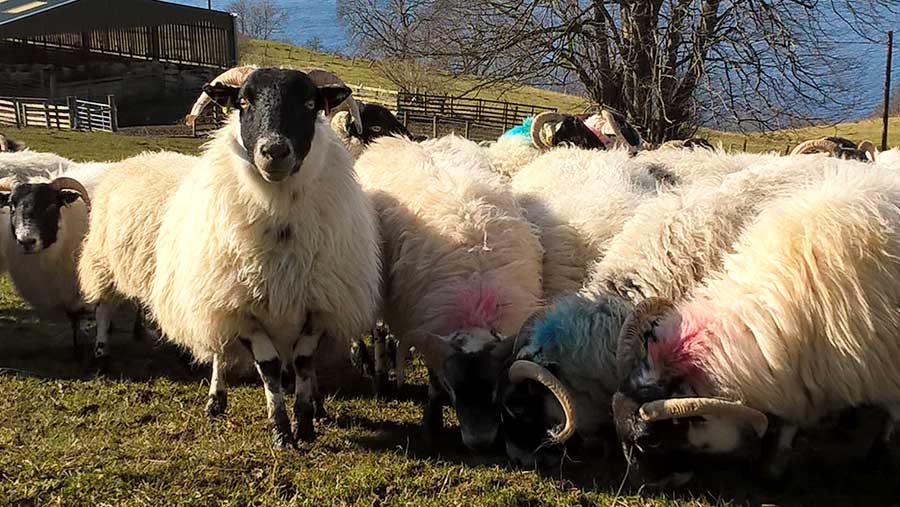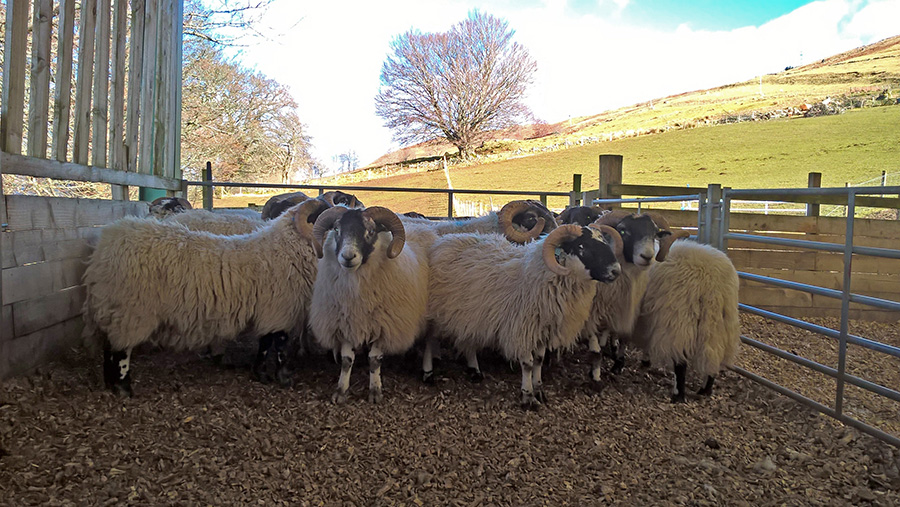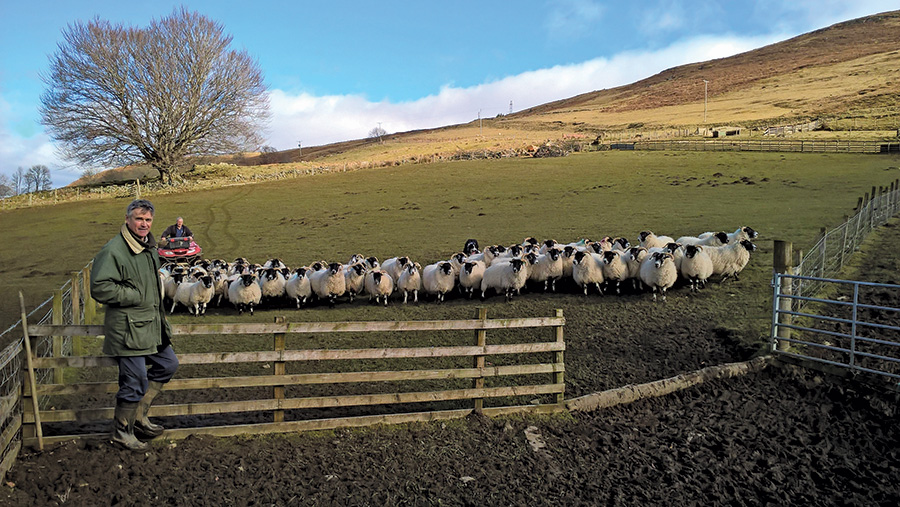Flock recording pays dividends on Blackface sheep farm

Enormous genetic gains have been reported on a Perthshire hill farm since the leap was taken to performance record its Scottish Blackface flock.
The pure flock at Wester Tullich, Aberfeldy, were well below the breed’s genetic average back in 1999, but by selecting stock on growth traits, maternal ability and high-index figures Ian Duncan Millar and shepherd Mark Armstrong have seen the farm’s best progeny rise to the top 1% of the breed.
After only four years in Signet’s scheme, the flock index increased from 74 in 1999 to 140 in 2004, overtaking the breed average of 131.
Last year the flock average was 316, well ahead of the 2016 breed average of 231.
See also: Database set to ease sheep recording burden
The genetic gains means lambs, which are fattened on kale at the Duncan Millar’s lowland farm, Tirinie, sold three weeks earlier. With finishing costs about £1.20 a head a week, this is saving more than £1,300 on lamb production costs.
“We sell between 380 and 400 lambs each year,” explains Mr Duncan Millar.
“In 2004 lambs averaged 18.4kg deadweight at an average slaughter date on 17 February. In 2014, however, lambs were 18.6kg with an average slaughter date of 30 January.”
Top lamb
|
|
Maternal comments |
Index |
Eight-week weight (kg) |
Scanning weight (kg) |
|
2004 |
Born a single raised a single |
227 (140 average) |
19 |
43 |
|
2015 |
Born twin raised a twin |
444 (316 average) |
19 |
39.5 |
Commercial decision
The upland system in place at Wester Tullich pushes the flock to maximise what they can from the available herbage available on the north-facing foothills of Meall nan Oighreag.
Lambs are speyned and taken off the hills in August/September before being finished on grazing, first on Tirinie grass until November before being moved on to kale.
All land is less favoured area, but is still “a green hill”, with little bracken or heather. Single bearing ewes lamb at 400m and then graze up to 760m.

“Performance recording has enabled us to identify the individuals and families that specifically thrive on that ground,” says Mr Duncan Millar, who stresses he is recording entirely for his own purposes.
See also: Boost sheep output by performance recording
Wester Tullich
- 620 pure Scotch Blackface ewes
- 12 Saler-cross cattle wintered at £30 a head
- 410ha stretching to 760m above sea level
Tirinie
- 130ha in seven to eight-year shift from barley, kale and grass
- 30ha spring malting barley drilled annually
- 40ha rented grassland
- 17ha to 18ha of kale finishes lambs
- 25 Saler cows plus heifers
- 500 Easycare crosses
“I don’t look to sell tups; the market is not there for us to do that – we sell about half a dozen tups a year. This is about identifying good stock we would otherwise miss and matching them appropriately to our system and increasing profitability – this farm has to stack up.”
Ahead of tupping, Signet data is analysed. A good-looking tup with a strong index but low muscle depth can be put to ewes with high muscle depth, he explains.
“It’s a management tool we use; balancing the performance records with sheep that look right and are structurally sound, and this year we are happy to see our top-ranked tup on the figures is also a good-looking strong sheep, which has not always been the case over the 16 years.”
The cost of performance recording has been covered by major savings on the annual tup buying budget. “There’s no getting away from it, performance recording is a lot of work,” he adds, stressing, however, that the process is neutral on a cost basis after investing £10,000 in technology.
The sheep pen now operates its second performance recording rig, consisting of weighing scales, EID-reading equipment and a computer-operated auto-drafter that can split sheep according to age, pregnancy and any data held by the computer, explains Mr Armstrong.
Growing gimmers
A typical year sees up to 200 replacements introduced to the flock after being wintered on lowland ground near Stranraer weighing 51kg. This is a marked improvement on the 38.5kgs in 1999, when Mr Duncan Millar became conscious of slow growth rates in replacement females.
“Subsequently gimmers now go on to the hills averaging 12.5kg more now than in 2000, meaning they have less growing to do on the hill and should be fit to do their job,” says Mr Duncan Millar.
Wester Tullich gimmer weights
|
Year |
Weight range (kg) |
Average (kg) |
|
1999 |
32-45 |
38.5 |
|
2004 |
38-61 |
49.5 |
|
2015 |
45-61 |
51 |
Informed breeding decisions
The flock was fitted with EID tags in 2000 and 200 ewes were selected and recorded. The bottom 50 were cleared out and a further 50 were brought in from the flock each year until a nucleus flock was reached in 2004.
“It was in 2004 when we went for it,” says Mr Duncan Millar, who places great importance on maternal ability and eight-week growth rate.
See also: Sheep performance recording ‘could help regain 25%’
“When numbers come back from Signet the first thing I look at is the overall index, this is important, and in terms of individual attributes, the mothering ability and milkiness of ewes is vital, so I look to eight-week weight.
“Like anything in breeding, if you focus on one attribute like mature size for example, you can get there very quickly but you lose some other key traits.”
Data gathering replaces lambing
Mr Armstrong says his job has changed from lambing sheep to being a “data gatherer”.
He has developed techniques to cope with the extra work involved when lambing on the hills. “A keen eye is needed when dealing with gimmers and first-crop lambs,” warns Mr Armstrong, who aims to weigh new-born lambs as soon as they’ve found their feet and started sucking.
“Ideally you don’t want to leave it longer than a day before doing this and easy-read tags comprising just the last three digits mean identifying wandering mothers is simple.”

Tag colours vary according to year and make matching mothers and lambs and data gathering much easier, with orange and yellow the easiest to read at distance.
“We have other colours such as green and pink for different years but ideally the larger tags with large numbers on can be seen on the quad from 10m away,” explains Mr Armstrong.
Occasionally, technology fails and for this reason there are contingency plans, namely; carrying pocketbooks and pencils and penning “non-reads” for later identification.
[AK – online these can go as bullet boxes to right – but be careful not too close to tables as will display oddly in some browsers]
Data gathering and flock management
- Scanning: Condition scoring and flukicide as advised by the vet no data gathering
- Pre-lambing: First pasteurella and clostridial inoculation protection for sheep, wormer and fluke as advised by vet.
- Lambing (late April): Data gathering, birth weights (tagging) and anti-tick treatment on lambs.
- Marking (late May): Eight-week weights and initial lamb pastuerella and clostridial and any other treatments only as advised by vet (in past this was anti-coccidiosis).
- Shearing (July): Second inoculation, anti-fly strike and wormer (as required).
- Weaning (early August): Lambs are dosed, fluked and sent to Tirinie. Distance readable tags given to all ewe hogg replacements as they go to the wintering.
- Backfat scanning (end September): 24-week weight data and any other treatment to make sure they are clean for away wintering for ewe hogs.
